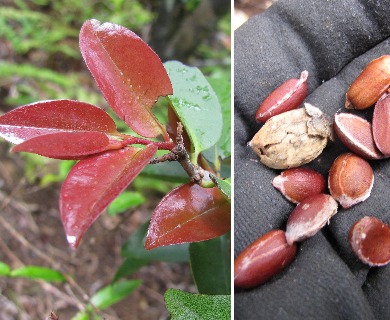Lama
Diospyros sandwicensis
Persimmons family (Ebenaceae)
Native species ()
Lama is widespread through the islands, especially in dry forests, and one of the most common trees. It has thick oblong or elliptical dull green leaves spreading in two rows on nearly horizontal twigs, small whitish flowers mostly single and almost stalkless at leaf bases, and yellow to orange egg-shaped or elliptical 5⁄8–3⁄4 inch (15–20 ) long.

©2010 Forest And Kim Starr
Leaves in two rows, with short brown hairy leaf-stalks of 1⁄4 inch (6 ). Blades oblong or elliptical, 1 1⁄4–2 1⁄2 inches (3–6 ) long and 5⁄8–1 1⁄4 inches (1.5–3 ) wide, blunt or short-pointed at rounded at base, slightly turned under at edges, thick and stiff, slightly curved up on sides from with side veins fine and not visible, red with pink flushes and hairy when young, above dull green, beneath dull light green.
Flowers male and female on different plants (), single and almost stalkless at leaf bases, about 1⁄4 inch (6 ) long. Male flowers have hairy greenish tubular with 3–4 blunt tubular bell-shaped whitish with three spreading and 12–18 Female flowers have and with hairy three-celled and three-forked
(berries) egg-shaped or elliptical, 5⁄8–3⁄4 inch (15–20 ) long, slightly curved on one side to blunt with point from at base is the enlarged cup-shaped finely hairy light green 1⁄4 inch (6 ) long with 3–4 blunt or rounded yellow flesh or dry. Seeds single or sometimes two, elliptical and flattened, 5⁄8 inch (15 ) long, brown.
often are abundant at maturity in late winter, especially February. Mature are sweetish and eaten by birds and people. Immature however, are slightly astringent, like those of their close relatives on the continental United States, persimmons (Diospyros virginiana L.).
The sapwood is wide and white. The heartwood is described as rich reddish-brown with redder and yellower zones, very hard, fine-textured, and straight grained. Hawaiians used the white wood as blocks in their altars to symbolize the goddess Laka, and to fence sacred enclosures. The place name Kapalama in Honolulu means lama fence and referred to a former fence around the school for the chief’s children there. The wood is not presently used.
Widespread and common in dry and wet regions through the islands down to sea level.
Special areas
Kokee, Waimea Arboretum, Wahiawa, Volcanoes
Champion
Height 35 ft (10.7 ), c.b.h. 2.8 ft (0.9 ), spread 17 ft (5.2 ). Puuwaawaa Ranch, Kailua-Kona, Hawaii (1968).
Range
All main Hawaiian Islands
Botanical
Maba sandwicensis A. DC., Diospyros ferrea var. sandwicensis (A. DC.) Bakh.
This variable species has many varieties. The common name lama means enlightenment.






